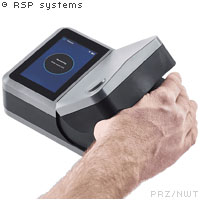A collaboration between TRUMPF Photonic Components and Danish company RSP Systems aims to enable wrist-worn glucose monitoring. TRUMPF will provide its VCSEL technology to the development of a corresponding sensor that will allow RSP Systems’ noninvasive technology for glucose monitoring to be miniaturized to a wearable format.
According to RSP Systems, the collaboration will lead to the first-ever clinically relevant wearable noninvasive glucose sensor.
“With our knowledge of the mechanisms of photonics, we can soon enable people with diabetes to measure their blood glucose levels more easily, more cheaply, and entirely without pain. This partnership once again shows the innovation potential of VCSEL technology,” CEO Berthold Schmidt of TRUMPF Photonic Components said.
Over the past 10 years, RSP has developed an accurate, factory calibrated, and clinically proven glucose monitor that provides glucose readings just by touching the skin and with no need for calibration. The company has since developed portable, optical, and sensor-based devices that can measure glucose levels, but the devices are the size of a paperback book.
“Together with TRUMPF Photonic Components, we will realize a wrist-worn device, aimed to cover all uses from people on insulin therapy to people at risk for developing diabetes, literally hundreds of millions of people,” CEO Anders Weber of RSP Systems said.

TRUMPF and RSP Systems are making it easier for people with diabetes to monitor their blood glucose levels. The companies are pairing TRUMPF VCSELs with RSP Systems' optical, sensor-based monitoring devices and incorporating the technologies into an on-wrist device. The partnership builds on existing Touch Glucose Monitoring (TGM) technology from RSP Systems. Courtesy of RSP Systems.
The concept of photonics-enabled wrist-worn glucose monitoring has been explored previously. In July 2021, England-based Rockley Photonics unveiled its “clinic on the wrist,” which was based on a miniaturized chip that provides continuous, noninvasive monitoring of core biomarkers. The sensor module used infrared spectroscopy technology that detected and monitored a much wider range of biomarkers than existing wearable consumer electronic devices that use green LEDs to monitor heart rate, according to Rockley. The company said at the time that its sensor module generated a large number of discrete laser outputs from a single silicon chip that covered a broad optical band. In addition to measuring heart rate and glucose trends, the module could also enable wearable devices to monitor core body temperature, blood pressure, body hydration, and more, Rockley said.
Other wearable systems for glucose monitoring in recent years have explored the use of Raman spectroscopy, dielectric spectroscopy, and quantum cascade lasers (QCLs).
According to the International Diabetes Federation, approximately 540 million adults worldwide live with diabetes, with half of those individuals not yet diagnosed. By 2030, the number of people affected is expected to rise to 643 million and, by 2045, to 783 million.
“If we are successful together, we will improve the lives of hundreds of millions of people,” Schmidt said. TRUMPF lasers are used in smartphones, smartwatches, digital data transmission, and sensors for autonomous driving. He said VCSELs are clearing the way for a glucose sensor to be worn on the wrist enabling monitoring at all times.
In 2022, TRUMPF formed a partnership with KDPOF — a Spanish provider of high-speed optical networking solutions — to apply TRUMPF VCSEL technology to automotive datacom solutions. The company also last year led a more than $15 million funding round into SensiBel, a microphone technology company. SensiBel’s optical MEMS microphones use lightwaves to measure the movement of a membrane that is set in motion by sound waves. Light is projected onto the membrane via a diffraction grating by means of a VCSEL.